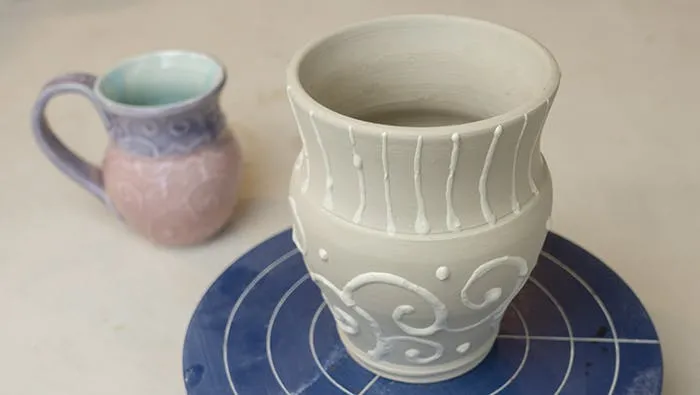Blog
Mastering the Art of Virtual Pottery Slip Trailing

For those who are captivated by the tactile and artistic nature of pottery but may not have access to a traditional studio setup, virtual pottery slip trailing offers an exciting and accessible avenue for creative exploration.
As someone who has always been fascinated by the transformative qualities of clay, I’ve been exploring different methods of pottery making, and slip trailing has become a recent favorite. The beauty of this technique lies in its simplicity and the endless creative possibilities it presents.
This comprehensive guide will equip you with the knowledge and techniques to embark on your virtual pottery slip trailing journey, even from the comfort of your own home.
Understanding Virtual Pottery Slip Trailing
Before we delve into the practicalities, let’s first define slip trailing. It is a decorative technique used in pottery where a liquid clay mixture, known as slip, is applied to the surface of a leather-hard clay piece.
The slip is usually dispensed through a fine-tipped applicator, much like icing a cake, to create intricate designs, patterns, or textures.
Virtual pottery slip trailing simulates this process in the digital realm. Using 3D modeling software designed for ceramics, you can recreate the experience of manipulating slip on a virtual piece of pottery.
Essential Tools and Materials
While we won’t be needing physical clay for virtual slip trailing, here are the digital equivalents that will bring your designs to life:
- 3D Modeling Software: This is your virtual pottery studio! There are several options available, some specifically geared towards ceramics, offering tools designed to mimic real-life pottery techniques.
- Digital Slip Applicator Tools: These tools within the software simulate the behavior of real-life slip trailers, enabling you to control the flow, thickness, and application of your virtual slip.
- Digital Pottery Forms: Begin with pre-made digital models of bowls, mugs, plates, or unleash your creativity by sculpting your own from scratch using the software’s sculpting tools.
- Digital Slip Textures and Colors: Experiment with an endless array of colors and textures to customize your digital slip, replicating the look of real-life glazes.
Step-by-Step Guide to Virtual Slip Trailing
Let’s break down the process of virtual pottery slip trailing into manageable steps:
1. Preparing Your Digital Canvas:
- Begin by selecting your desired digital pottery form. This could be a pre-loaded model or one that you’ve created yourself.
- Ensure your digital form is in the ‘leather hard’ stage, meaning it’s dry enough to hold its shape but still slightly malleable in the digital environment.
2. Choosing Your Digital Slip:
- Experiment with a wide variety of digital slips, each mimicking the properties of real-life slip recipes.
- Adjust the consistency, color, and texture of your chosen slip to achieve your desired effect.
3. Mastering the Digital Slip Trailing Technique:
- Select your preferred digital slip trailing tool.
- Practice applying steady and controlled pressure to the tool, mimicking the movement of a real-life slip trailer.
- Explore different tip sizes and shapes to achieve varied line weights and textures.
- Don’t be afraid to experiment! Virtual slip trailing, unlike its real-life counterpart, allows for unlimited do-overs.
4. Bringing Your Designs to Life:
- Layer different colors and textures of digital slip to create depth and visual interest.
- Incorporate patterns, designs, and imagery into your slip trailing, replicating traditional or contemporary styles.
5. Refining and Finalizing:
- Once you’re satisfied with your slip trailing design, allow your piece to digitally dry. This step ensures the slip sets properly, preventing smudging or distortion.
- Apply digital glazes to enhance the colors and textures of your piece, creating a realistic ceramic finish.
 Slip Trailing
Slip Trailing
Benefits of Virtual Pottery Slip Trailing
Virtual pottery slip trailing offers a myriad of benefits, making it an appealing option for both seasoned potters and beginners alike:
- Accessibility: Break free from the limitations of a physical studio and enjoy the freedom to create whenever and wherever inspiration strikes.
- Cost-Effectiveness: Virtual slip trailing eliminates the need for expensive materials, equipment, and studio space.
- Unlimited Experimentation: Embrace the freedom to experiment without the fear of wasting precious materials.
- Precision and Control: Digital tools often offer a heightened level of precision, allowing for intricate details and complex designs.
From Virtual to Reality: Bridging the Gap
While virtual pottery slip trailing provides a fantastic platform for learning and experimentation, the desire to translate these digital creations into tangible pieces is a natural progression.
“Many potters find that their virtual explorations inform and enhance their work in the real studio,” says ceramic artist and educator, Sarah Williams. “The skills and design aesthetics developed digitally can seamlessly transition into the physical realm.”
Here at Robert Kline Art, we encourage you to view virtual pottery slip trailing as a stepping stone, a bridge between the digital and physical worlds of pottery.
Embark on Your Creative Journey
Virtual pottery slip trailing opens up a world of creative possibilities. It’s a fun, engaging, and accessible way to learn about pottery techniques, experiment with different designs, and bring your artistic vision to life.
So, why wait? Dive into the exciting realm of virtual pottery and discover the endless possibilities that await!
We’d love to see your virtual pottery creations! Share your work and connect with fellow pottery enthusiasts on the Robert Kline Art community forum. Happy potting!
